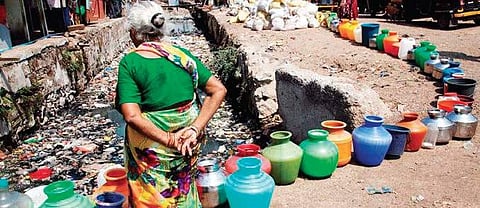

Pollution is the introduction of contaminants that cause adverse changes. Contamination is destroying nature, making any resource unfit for the next intended use. Pollution is because of people, whereas contamination may be natural. Contaminated water is common, and sometimes it might not hurt. Polluted water is always dangerous to the environment and humans. Rainwater leaches out chemicals from wastes dumped above ground and the runoff invariably meets with surface water. Sometimes it slowly percolates and finally mixes with water at great depths. Little can we do about natural contaminants, but a lot can be done in the fight against water pollution.
Surface water includes rivers, lakes, ponds, streams, and the oceans. One major cause of surface water pollution is depletion and overuse. “In the Ganga basin approximately 12,000 million litres per day (mld) of sewage is generated, for which presently there is a treatment capacity of only around 4,000 mld. Approximately 3,000 mld of sewage is discharged into the main stem of the river Ganga from the Class I & II towns located along the banks, against which treatment capacity of about 1,000 mld has been created till date.
The contribution of industrial pollution, tannery wastes in Kanpur and others, is about 20% volume wise but due to its toxic and non-biodegradable nature has much greater significance. The deterioration in water quality impacts people immediately. The Ganga, in some stretches, particularly during lean seasons, has become unfit even for bathing. The threat of global climate change, the effect of glacial melt on Ganga flow and the impacts of infrastructural projects in the upper reaches of the river, raise issues that need a comprehensive response.” (Source: http://nmcg.nic.in/pollution.aspx)
Water absorbed by the topsoil collects in aquifers that move around at great depths. India’s primary sources of fresh water are deep borewells, especially for agriculture. They are being depleted relentlessly as people fight water shortages. Everyone can make small changes to protect fresh water sources. Use of harsh cleaning agents in toilets, car wash detergents and anti-tick shampoos for pets maybe done only where proper drains lead to a water treatment system before discharge. Pesticides harm the environment as well as humans, and is therefore prudent to avoid even for gardening as a hobby.
Shampoos and face scrubs have plastic micro-granules which contaminate all surface water sources severely. Flushing garbage, unused medicines or chemicals down the drains can leach substances through damaged pipes into the groundwater. E-wastes contain heavy and rare metallic compounds which are dangerous to health. Recycling batteries, empty printer ink cartridges and other small electronic components is a great habit to cultivate. A septic tank maintained annually brings to notice any leaks and avoids pollutants seeping into earth.
In short, switching to natural alternatives or mild soaps for cleaning and washing, and using organic alternatives even for repellents protects precious water sources. Never trash carelessly, as mindless dumping or discharge of any waste invariably reaches both ground and surface water. It might seem exaggerated, but littering even once causes water pollution! Don’t be a polluter, preserve water for ourselves and for future generations.